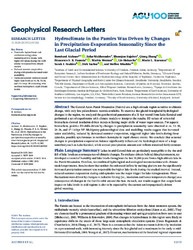Hydroclimate in the Pamirs Was Driven by Changes in Precipitation-Evaporation Seasonality Since the Last Glacial Period
Makhmudov, Zafar
Rajabov, Ilhomjon
DOI: https://doi.org/10.1029/2019GL085202
Persistent URL: http://resolver.sub.uni-goettingen.de/purl?gldocs-11858/9419
Persistent URL: http://resolver.sub.uni-goettingen.de/purl?gldocs-11858/9419
Aichner, Bernhard; Makhmudov, Zafar; Rajabov, Ilhomjon; Zhang, Qiong; Pausata, Francesco S. R.; Werner, Martin; Heinecke, Liv; Kuessner, Marie L.; Feakins, Sarah J.; Sachse, Dirk; Mischke, Steffen, 2019: Hydroclimate in the Pamirs Was Driven by Changes in Precipitation-Evaporation Seasonality Since the Last Glacial Period. In: Geophysical Research Letters, Band 46, 23: 13972 - 13983, DOI: 10.1029/2019GL085202.
 |
Dokument öffnen: |
The Central Asian Pamir Mountains (Pamirs) are a high-altitude region sensitive to climatic change, with only few paleoclimatic records available. To examine the glacial-interglacial hydrological changes in the region, we analyzed the geochemical parameters of a 31-kyr record from Lake Karakul and performed a set of experiments with climate models to interpret the results. δD values of terrestrial biomarkers showed insolation-driven trends reflecting major shifts of water vapor sources. For aquatic biomarkers, positive δD shifts driven by changes in precipitation seasonality were observed at ca. 31–30, 28–26, and 17–14 kyr BP. Multiproxy paleoecological data and modelling results suggest that increased water availability, induced by decreased summer evaporation, triggered higher lake levels during those episodes, possibly synchronous to northern hemispheric rapid climate events. We conclude that seasonal changes in precipitation-evaporation balance significantly influenced the hydrological state of a large waterbody such as Lake Karakul, while annual precipitation amount and inflows remained fairly constant.
Statistik:
ZugriffsstatistikSammlung:
This is an open access article under the terms of the Creative Commons Attribution License, which permits use, distribution and reproduction in any medium, provided the original work is properly cited.

